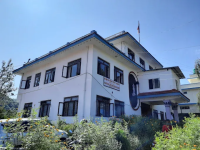National
The stop-start Melamchi drinking water project
Project aims to resume distribution in Valley tomorrow. But there is no guarantee of regular long-term supply.
Prithivi Man Shrestha
In the past month, Kathmandu Valley has seen at least two demonstrations—in Tinkune, Kathmandu and Mangalbazar, Lalitpur—that asked for a speedy supply of Melamchi’s water to the Valley.
This wouldn’t be the first time the Melamchi Water Supply Project delivers water from the eponymous river in Sindhupalchok to Kathmandu’s households, having done so at least twice after the project’s completion in 2021.
In June 2023 last year, the project stopped supplying water to the Valley, citing potential damage to its tunnel from monsoon floods. The water supply was supposed to be halted for only two months but the disruption continued for much longer, forcing Valley dwellers to hit the streets. The project’s water was previously supplied in December, 2022.
The Melamchi Water Supply Board delivers water to Kathmandu Valley through a temporary water diversion most of the year except in the monsoon, when floods can damage the tunnel.
Since the devastating 2021 Melamchi flooding, which caused significant damage to the project, it has been distributing water in Kathmandu with temporary infrastructure.
Supported by the Asian Development Bank (ADB), the project was designed to divert 170 million litres of untreated water a day from the Melamchi river through a 26-km tunnel to Sundarijal, where it is treated.
Here is a primer on the project’s history, the disasters it has endured and when it will resume supplying water to Kathmandu.
The resumption of supply
Zakki Ahmad Ansari, executive director of the Melamchi Water Supply Development Board, said they hope to distribute water in Kathmandu Valley starting Monday, January 15.
“Water has already been diverted into the tunnel,” Ansari said, adding that distribution will resume once the tunnel is filled with water within 2-3 days. The tunnel was cleaned up before water was channelled into it. Sino Hydro, the Chinese company whose contract was supposed to expire at the end of December, was tasked with the clean-up.
On December 19, 2023, a meeting of the Melamchi Water Supply Board signed a memorandum of understanding with SinoHydro for the Chinese company to clear the project’s headworks and the tunnel.
The tunnel needed to be cleaned up as muddy water had entered it during the monsoon, according to Rajendra Prasad Pant, spokesperson for the Melamchi Water Supply Board. After the tunnel is filled with clean water, the water will be routed to the treatment plant in Sundarijal, Kathmandu before being distributed to Valley households.
The Kathmandu Upatyaka Khanepani Limited, which is responsible for the distribution of water in the Valley, is also working to plug the leakages in the water distribution system before Melamchi’s water is stored at Sundarijal-based water treatment plant.
Gyanendra Bahadur Karki, the KUKL chief executive officer, said repair and maintenance works continued at four storage tanks in preparation for water distribution in Kathmandu.
“We started repairs at the Chabahil-based storage tank on Friday,” he said. This is the storage for water distributed to Balaju, Anamnagar, Khumaltar, and Minbhawan, among other areas.
“Repairs of other smaller water storage tanks meant for delivering water to Bhaktapur will also be completed before Melamchi’s water is poured into the Sundarijal-based treatment plant,” Karki said.
The KUKL has been distributing Melamchi water with both old and new pipelines in the Valley. After the eventual exit of the Chinese company, Melamchi is also appointing a separate company to look after the tunnel and its operation.
On January 12, the board invited a re-tender for the task of operation and maintenance of the Melamchi Diversion Tunnel Through Alternate Diversion System including Ancillary Civil Works, Security and Project Camps Services. “After SinoHydro’s exit, a new company will be responsible for the maintenance and operation of the tunnel,” said Pant.
Why was Melamchi’s water supply delayed this year?
Water from the Melamchi river could not be diverted on time as the floods on the river on August 13 and 14 last year had damaged the headworks and access roads, the board said in a statement on December 19.
The fresh damage forced the board to issue an extra variation order for the repair work, for which it had to pay an additional amount to the contractor. Then two reasons in particular delayed repair works, according to the board: delay in paying the contractor and obstruction caused by local traders who had supplied materials to the former Melamchi contractor—the Italian Cooperativa Muratori e Cementisti (CMC) di Ravenna—but hadn’t received the payment for that.
Ansari said a proposal for solving these issues is under consideration of the water supply ministry.
On the other hand, officials said it also took time to convince the Chinese contractor to prolong the contract for the maintenance and sanitation works at the temporary structure.
Pant said the Chinese contractor didn’t want to prolong the contract after completing the repair of the infrastructure damaged in the floods of June, 2021. “But it has finally agreed to extend the contract to carry out sanitation works at the headworks and in the tunnel in order to enable us to deliver water to Kathmandu,” he said.
Will there be a permanent solution?
In March 2021, following the completion of tunnel works, water from the Melamchi in Sindhupalchok district finally made it to Kathmandu after a decades-long wait and breaching of countless deadlines. With the headworks incomplete, water was distributed through a temporary diversion.
The tunnel’s headworks were in an advanced stage of completion, with major parts of the structures built and hydro-mechanical equipment and instrumentation installed.
On June 15, 2021, the board started dewatering the tunnel for inspection. It aimed to complete the remaining works at the headworks and the tunnel, including any rectifications identified during the inspection, and to commission the Melamchi River Water Diversion Subproject in its entirety by September, 2021.
But the jubilation of the water arriving in Kathmandu from the distant river was short-lived as catastrophic flooding caused significant damage to the near-completed project.
Due to the flooding, the headworks were covered in 20-24 metres of debris, but the tunnel remained safe as it was closed, according to the Ministry of Water Supply. Even though the water supply to Kathmandu was restored via the temporary structure, little has been done to uncover the headworks, according to officials. The ADB, the main lender for the development project, was studying the damage and exploring ways to minimise similar risks in future.
The ADB came up with a study report in November last year. It emphasised that a comprehensive catchment strategy centred on disaster risk reduction and early warning systems, with measures to stabilise the river and control erosion, can help protect Melamchi’s critical infrastructure from future events and boost the Capital’s water security.
The report suggested relocating the headworks to an area with a lower risk of devastating hazards. “Due to the extreme geomorphological and hydrological processes in the catchment, it would be impossible to control all the landslides, floods, and debris flows that threaten the current location of the headworks,” the report says. “For the long term, therefore, the relocation of the headworks to an area with lower risk from devastating hazards should be considered.”
According to Ansari, the ADB has suggested that new headworks be built 500-600 metres above the current location. “A design of the headworks has also been prepared but the government is yet to approve it,” he said.
If the headworks are relocated, the tunnel should also be extended up to the new site. “A proposal has been forwarded to extend the tunnel by 900 metres,” said Ansari.
Officials said that fresh bids will have to be invited to build both the tunnel and the headworks after the relocation. “As a new design is under review, we are not sure how long it will take to build the new headworks at a new location and when a permanent structure to supply water to Kathmandu Valley will be completed,” said Ansari.
Over the years, the national pride project was embroiled in controversies and plagued by several delays. After the Italian contractor abandoned the project in December 2018 over a financial dispute with the government, a Chinese contractor was hired in September 2019 to complete the remaining works.
Then the Covid-19 pandemic struck and hit its progress. At the time, the much-awaited project was on course to meet its fresh deadline of mid-July 2020 for supplying water to Kathmandu. Then came the floods.
Back to the 2021 floods
According to the ADB’s report, two major floods and the debris they brought damaged the Melamchi project’s structure in the monsoon of 2021.
There was flooding on June 15, 2021, after heavy rainfall and a glacial lake outburst in the upper reaches of the river’s catchment. This was followed by a similar event on August 1, 2021 that was caused by rainfall and a landslide dam outburst flood in the Melamchi catchment.
The origin of these events can be traced back to the 7.8-magnitude 2015 Gorkha Earthquake that increased the geological fragility of the catchment and its susceptibility to land instabilities, according to the report.
In the Melamchi catchment, the earthquake triggered 12 landslides on the right riverbank between the Bhemathan knickpoint and the headworks, and at least two on the left bank, the report says.
The subsequent precipitation and sharp temperature rise during the 2021 monsoon generated a Glacier Lake Outburst Flood in the upper reaches of the catchment that triggered the collapse of a large pre-existing sediment deposit in the river channel at Bhemathan, about 16 km upstream of the headworks.
The erosion caused by the flows from Bhemathan, coupled with prolonged rainfall in the catchment, triggered a major landslide further downstream, damming the river.
“Breaching of this natural dam generated outburst floods from the lake that formed behind it,” the report said, “and this, in turn, created new natural dams whose breach caused additional outburst floods.”



 16.12°C Kathmandu
16.12°C Kathmandu













%20(1).jpg&w=300&height=200)

